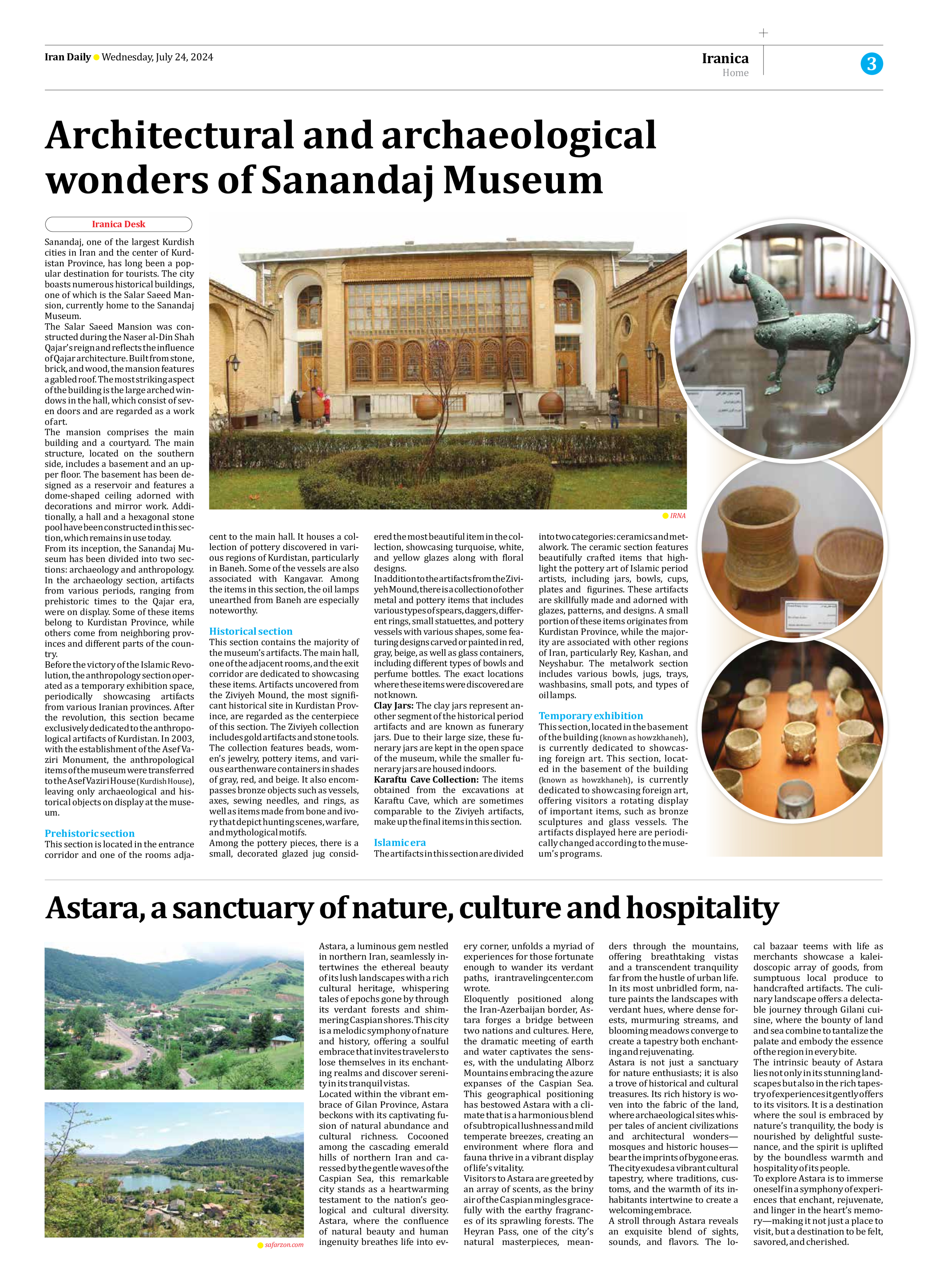
Architectural and archaeological wonders of Sanandaj Museum
Sanandaj, one of the largest Kurdish cities in Iran and the center of Kurdistan Province, has long been a popular destination for tourists. The city boasts numerous historical buildings, one of which is the Salar Saeed Mansion, currently home to the Sanandaj Museum.
The Salar Saeed Mansion was constructed during the Naser al-Din Shah Qajar’s reign and reflects the influence of Qajar architecture. Built from stone, brick, and wood, the mansion features a gabled roof. The most striking aspect of the building is the large arched windows in the hall, which consist of seven doors and are regarded as a work of art.
The mansion comprises the main building and a courtyard. The main structure, located on the southern side, includes a basement and an upper floor. The basement has been designed as a reservoir and features a dome-shaped ceiling adorned with decorations and mirror work. Additionally, a hall and a hexagonal stone pool have been constructed in this section, which remains in use today.
From its inception, the Sanandaj Museum has been divided into two sections: archaeology and anthropology. In the archaeology section, artifacts from various periods, ranging from prehistoric times to the Qajar era, were on display. Some of these items belong to Kurdistan Province, while others come from neighboring provinces and different parts of the country.
Before the victory of the Islamic Revolution, the anthropology section operated as a temporary exhibition space, periodically showcasing artifacts from various Iranian provinces. After the revolution, this section became exclusively dedicated to the anthropological artifacts of Kurdistan. In 2003, with the establishment of the Asef Vaziri Monument, the anthropological items of the museum were transferred to the Asef Vaziri House (Kurdish House), leaving only archaeological and historical objects on display at the museum.
Prehistoric section
This section is located in the entrance corridor and one of the rooms adjacent to the main hall. It houses a collection of pottery discovered in various regions of Kurdistan, particularly in Baneh. Some of the vessels are also associated with Kangavar. Among the items in this section, the oil lamps unearthed from Baneh are especially noteworthy.
Historical section
This section contains the majority of the museum’s artifacts. The main hall, one of the adjacent rooms, and the exit corridor are dedicated to showcasing these items. Artifacts uncovered from the Ziviyeh Mound, the most significant historical site in Kurdistan Province, are regarded as the centerpiece of this section. The Ziviyeh collection includes gold artifacts and stone tools.
The collection features beads, women’s jewelry, pottery items, and various earthenware containers in shades of gray, red, and beige. It also encompasses bronze objects such as vessels, axes, sewing needles, and rings, as well as items made from bone and ivory that depict hunting scenes, warfare, and mythological motifs.
Among the pottery pieces, there is a small, decorated glazed jug considered the most beautiful item in the collection, showcasing turquoise, white, and yellow glazes along with floral designs.
In addition to the artifacts from the Ziviyeh Mound, there is a collection of other metal and pottery items that includes various types of spears, daggers, different rings, small statuettes, and pottery vessels with various shapes, some featuring designs carved or painted in red, gray, beige, as well as glass containers, including different types of bowls and perfume bottles. The exact locations where these items were discovered are not known.
Clay Jars: The clay jars represent another segment of the historical period artifacts and are known as funerary jars. Due to their large size, these funerary jars are kept in the open space of the museum, while the smaller funerary jars are housed indoors.
Karaftu Cave Collection: The items obtained from the excavations at Karaftu Cave, which are sometimes comparable to the Ziviyeh artifacts, make up the final items in this section.
Islamic era
The artifacts in this section are divided into two categories: ceramics and metalwork. The ceramic section features beautifully crafted items that highlight the pottery art of Islamic period artists, including jars, bowls, cups, plates and figurines. These artifacts are skillfully made and adorned with glazes, patterns, and designs. A small portion of these items originates from Kurdistan Province, while the majority are associated with other regions of Iran, particularly Rey, Kashan, and Neyshabur. The metalwork section includes various bowls, jugs, trays, washbasins, small pots, and types of oil lamps.
Temporary exhibition
This section, located in the basement of the building (known as howzkhaneh), is currently dedicated to showcasing foreign art. This section, located in the basement of the building (known as howzkhaneh), is currently dedicated to showcasing foreign art, offering visitors a rotating display of important items, such as bronze sculptures and glass vessels. The artifacts displayed here are periodically changed according to the museum’s programs.







